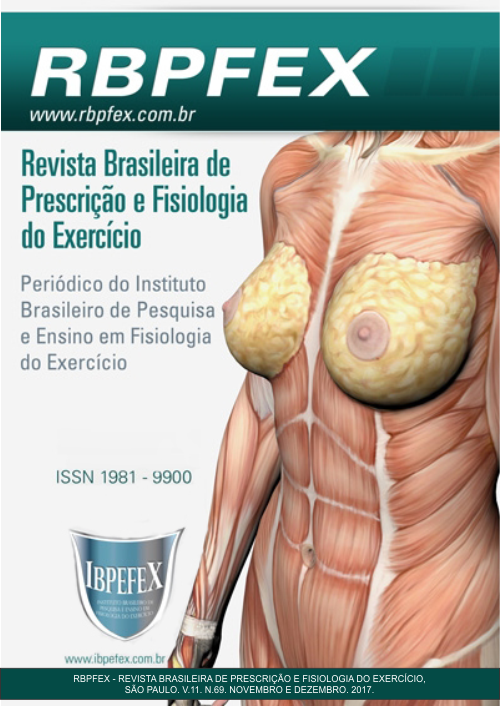Fencers morphophysiological profile after 12 weeks of training
Abstract
The present study aimed to determine the female fencers morphophysiological profile, after 12 weeks of periodized training. The sample consisted in four female fencing athletes with 25.4 ± 4.35 years, training 5 days a week with 3 hours per day. The athletes were submitted to two anthropometric evaluations, one pre and other post-training of 12 weeks. These evaluations included the following measurements: total body mass, stature, wingspan, fat percentage, localized muscular resistance biomotors tests, arm and abdominal flexion in 1 minute. The data were tabulated and statistically evaluated by means of the median, first and third quartiles, amplitude (minimum and maximum), interquartile range and coefficient of variation (CV). The statistical difference was established by the non parametric Mann - Whitney (p<0.05), calculated in the software Bio State 5.0, year 2007. The total body mass showed an increase of 3.7% from the first to the second evaluation, due to lean mass increase 7.3%, decrease in fat mass 4.9% and fat percentage 9.5%. The skinfolds that had the most changes in their thickness were pectoral folds 42.9% and axillary mean 20.5%. The arm and abdominal flexion tests in 1 min showed an increase in skeletal muscle strength of 29.9% and 13.4%, respectively. Therefore, the data suggest an improvement in the performance of the athletes after twelve weeks where the periodization training occurred.
References
-Bottoms, L. M.; Sinclair, J.; Gabrysz, T.; Szmatlan-Gabrysz, U.; Price, M.J. Physiological responses and energy expenditure to simulated epee fencing in elite female fencers. Serbian Journal of Sports Sciences. Vol. 5. Num. 1. 2011. p. 17-20.
-Cunha, R. S. P.; Filho, J. F. Identificação do perfil dermatoglífico, somatotípico e das qualidades básicas da equipe brasileira feminina de esgrima. Fitness &Performance. Vol. 4. Num. 1. 2005. p. 34-44.
-Gabbett, T.; Georgieff, B. Physiological and anthropometric characteristics of Australian junior national state, and novice volleyball players. J Strength Cond Res. Vol. 21, Num. 3. 2007. p. 902-908.
-Jackson, A. S.; Pollock, M. L. Generalized equations for predicting body density of men. The British Journal of Nutrition. Vol. 40. 1978. p. 497-504.
-Jackson, A. S.; Pollock, M. L.; Ward, A. Generalized equations for predicting body density of women. Medicine Science Sports Exercise. Vol. 12. 1980. p. 175-182.
-Marinho, B. F.; Marins, J. C. B. Teste de força/resistência de membros superiores: análise metodológica e dados normativos. Fisioterapia em Movimento. Curitiba. Vol. 25. Num. 1. 2012. p. 219-230.
-Mcardle, W. D.; Katch, F. I.; Katch, V. L. Exercise Physiology: Nutrition, Energy, and Human Performance. editors. Lippincott Williams -Wilkins. 2010. p. 1038.
-Moura, J. A. R de; Albano, T.; Veller, G.; Machado, W.; Peixoto, E. Efeito de 24 sessões de treinamento aeróbio, força-resistência muscular e flexibilidade, realizados em academia de ginástica sobre parâmetros neuromotores, cardiovasculares e morfológicos. EFDeportes.com Revista Digital. Buenos Aires. 2011. Num. 155.
-Obmiński, Z.; Ladyga, M.; Starczewska-Czapowska, J.; Borkowski, L. Physiological and biomechanical symptoms of physical adaptation to anaerobic and endurance exercises after 3-month period of increased sport activity in female fencers. Journal of Combat Sports and Martial Art. Vol. 1. Num. 2. 2011. p. 13-18.
-Prado, W. L.; Botero, J. P.; Guerra, R. L. F.; Rodrigues, C. L.; Cuvello, L. C.; Dâmaso, A. R. Perfil antropométrico e ingestão de macronutrientes em atletas profissionais brasileiros de futebol, de acordo com suas posições. Revista Brasileira de Medicina do Esporte. Vol. 12. Num. 2. 2006. p. 61-65.
-Pollock, M. L.; Wilmore, J. H. Exercícios na saúde e na doença: avaliação e prescrição para prevenção e reabilitação. São Paulo. Médica e Científica. 1993.
-PROESP-BR. Manual do Projeto Esporte Brasil. 2012. Disponível em: <http://www.proesp.ufrgs.br/proesp>.
-Reilly, T.; Duran, D. Fitness assessment. In: Reilly, T.; Williams, A.M. editors. Science and soccer. 2ªedição London. Routledge. 2003. p. 21-48.
-Ribeiro, C.; Campos, D. História da Esgrima, da criação à atualidade. Revista de Educação Física. 2007. p. 137-165.
-Roi, G. S.; Bianchedi, D. The science of fencing: implications for performance and injury prevention. Sports Medicine, Vol. 38. Num. 6. 2008. p. 465-481.
-Siri, W. E. Body composition from fluid spaces and density. In: Brozek, J.;Henschel A. (Eds.). Techniques for measuring body composition. Washington: National Academy of Science. 1961. p. 223-244.
-Tsolakis, C.; Kostaki, E.; Vagenas, G. Anthropometric, flexibility, strength-power, and sport-specific correlates in elite fencing. Percept Mot Skills. Vol. 110. Num. 3. 2010.
-Velázquez, J. R. La nueva didáctica de la esgrima. Buenos Aires. 2004.
Authors who publish in this journal agree to the following terms:
- Authors retain the copyright and grant the journal the right of first publication, with work simultaneously licensed under the Creative Commons Attribution License BY-NC which allows the sharing of the work with acknowledgment of the authorship of the work and initial publication in this journal.
- Authors are authorized to enter into additional contracts separately for non-exclusive distribution of the version of the work published in this journal (eg, publishing in institutional repository or book chapter), with acknowledgment of authorship and initial publication in this journal.
- Authors are allowed and encouraged to post and distribute their work online (eg, in institutional repositories or on their personal page) at any point before or during the editorial process, as this can bring about productive change as well as increase impact and impact. citation of published work (See The Effect of Free Access).






